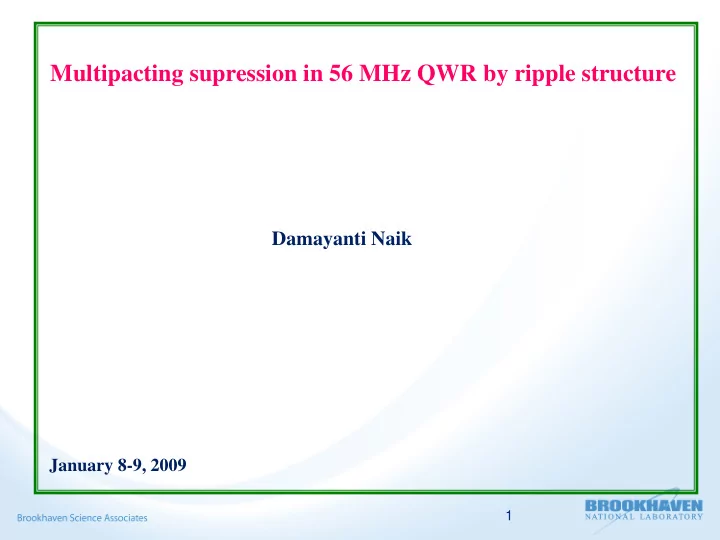

Multipacting supression in 56 MHz QWR by ripple structure Damayanti Naik January 8-9, 2009 1
Requirement of Multipacting simulation in 56 MHz QWR Multipacting is expected Consequences 1. RF structure under vacuum 1. Unable to work to its full capacity 2. Symmetrical (without coupler and dampers, 2. Niobium may be quenched cavity has axial symmetric geometry) Simulation by 2D multipac 2.1 code 1. works for axial symmetric RF structure 2. Uses Finite Element Method field solver and calculates time harmonic e.m field 3. Locates multipacting field levels, aided by data on secondary yield of cavity material 4. Details resonant trajectories of electrons 2
Representation of multipacting by code 1. Triplot I. Ratio of total number of free electrons after N impacts to initial electrons; C N /C 0 (Counter function) II. Final impact energy of electrons after N impacts E fN III. Ratio of total number of secondary electrons after N impacts to initial number of electrons; e N /C 0 (Enhanced counter function) Counter function Code calculates for N = 20 impacts to find multpacting probable zone. a. C 20 /C 0 >1 Final impact energy b. 54 eV <E f20 < 1554 eV c. e 20 /C 0 >1. However, to confirm severity, Enhanced counter function for present work N = 100, e 100 /C 0 ≥ 10 5 has been considered. 3
2. Trajectory of the electron Resonant trajectory of electron in (r, z) and (r, t) plane. 4
Simulation 20-40cm initial points Electric and magnetic field distribution Peak surface electric field: 44.19 MV/m Maximum magnetic field: 1054 Gauss 5
Triplot Multipacting found at peak surface electric field level 25, 31, 35-37, 47 kV/m 6
Electron trajectory at 25 kV/m Single-point multipacting 7
Electron trajectory at 31 kV/m Two-point multipacting 8
Electron trajectory at 35 kV/m Two-point multipacting, walking away from gap , towards closed end of cavity 9
Electron trajectory at 47 kV/m Single-point multipacting 10
Multipacting features *Trajectory continues more than half of cavity with a tendency to move towards end of cavity 11
*Irrespective of point of origin, electron impacts on outer conductor in single-point multipacting whereas both on inner and outer conductor in two-point multipacting. Electron generated on inner conductor at first moves towards outer conductor and then undergo single-point or two-point multipacting. * Electrons travelling from outer conductor to inner conductor do not necessarily follow the same path while reversing their direction; this accounts the different field strengths experienced by the electrons during their back and forth oscillation. *Field up to 50 kV/m favors these trajectories. Severity with electron impact number more than 100 • To assess the severity, simulation was continued for N>100 i.e 500, 1000 and more • Enhanced counter function increases significantly indicating an intense electron cloud in the cavity 12
Triplot (20 - 40cm) Electron impact number: 500 10 65 10 45 10 80 10 45 31 kV/m 36 kV/m 47 kV/m Electron impact number: 1000 10 130 10 164 10 100 13
Electron trajectory at 25 kV/m Electron impact number : 1000 14
Comparison with 80 MHz Legnaro QWR Electric and Magnetic field distribution 10 80 10 46 65 kV/m 71 kV/m Electron trajectory: 71 kV/m 15
Supression of multipacting Most effective way to stop multipacting by breaking electron’s stable resonant trajectory thereby preventing its further multiplication irrespective of cleanness of niobium surface. Various structure modification to stop multipacting Bigger radius (> 25 cm) of outer conductor Ripples pointing in downward direction 16
Ripples pointing in upward direction Optimization of ripples � To reduce manufacturing costs (ripples are optimized to a customary depth, width, and sufficiently separated) � They must leave sufficient space for coupler and dampers at the end of cavity 1. Depth 1 cm deep ripples are not allowed, as electron manages to have resonant trajectories in ripple zone, moving further and further, and multiplying electrons. Constraints on material’s curvature does not allow shallow ripples like 1-1.5 cm deep. 2 cm depths are found to more effective 17
2. Width • 1 cm wide ripple is not satisfactory as electrons can emerge from it. • In 3 cm ripple, electrons undergo resonant oscillation inside it and trapped there. Energy of electrons are only few eV less to have δ > 1 little impurity in Niobium, may lead to multipacting 2 cm wide ripples are good choice 18
3. Gap Stable trajectory of electron is favored by having gaps bigger than 2 cm gap of between ripples: 4 cm Stable electron trajectories for a gap of 4 cm between ripples 19
Electron trajectory with optimized 2 cm deep 2 cm wide 2 cm apart ripples Ripple specification 2 cm R=1 cm 2 cm 2 cm Break in trajectory with 2 cm gap, even for 20 impacts Adopted for fabricating the cavity 20
Conclusion 1. 2D simulation revealed sever multipacting in 56 MHz QWR 2. Can be eliminated by structurally modifying its walls Future Plan Since cavity is equipped with a coupler and dampers, which have not been taken into account in 2D simulation, a further complete simulation is being carried out with a suitable 3D code to confirm parameters for a multipacting free cavity, revealed by 2D code. 21
Recommend
More recommend